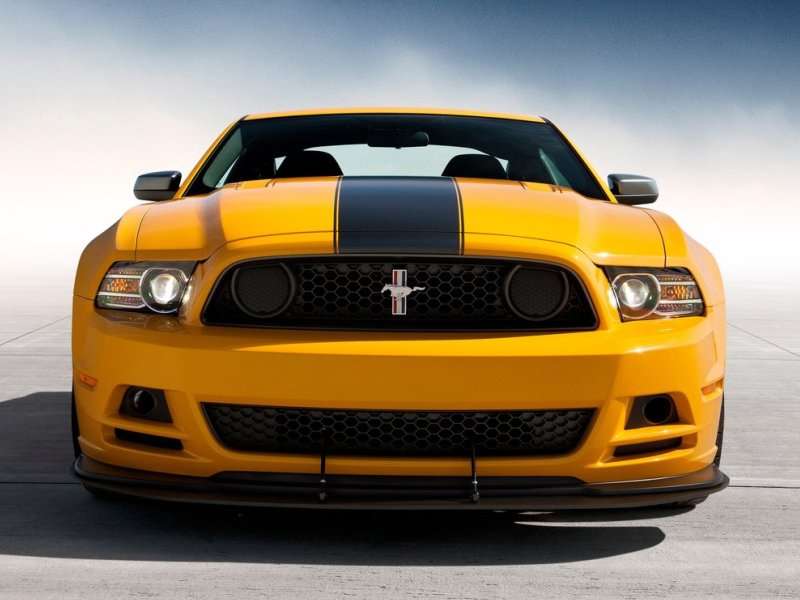Recent Articles
Popular Makes
Body Types
2013 Ford Mustang Boss 302 Road Test & Review
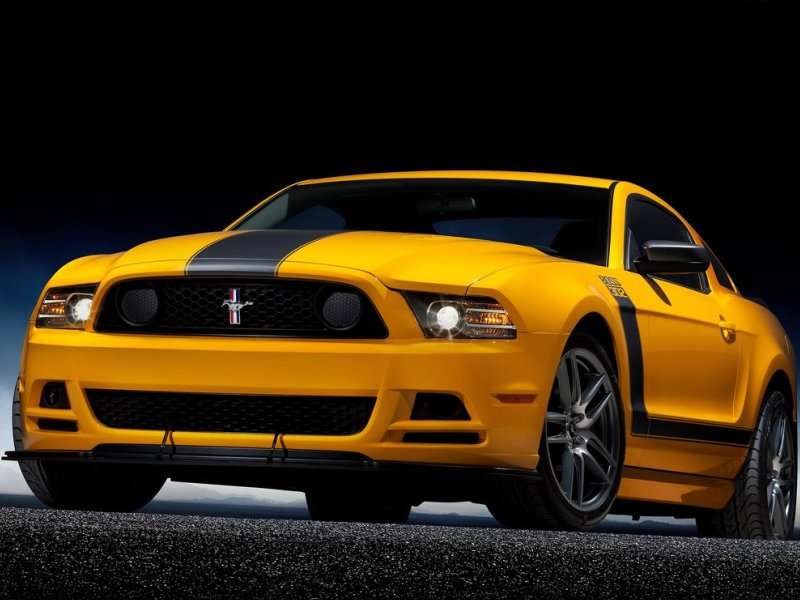
The granddaddy of American pony cars, and the car from which the pony car genre’s moniker was derived, Ford’s Mustang is the oldest and longest continually running nameplate in its class.
Where Camaro and Challenger — today literally caricatures of themselves — have come and gone and come again over the years, the Mustang has galloped on like Hidalgo across the Arabian desert. Overcoming unheard of adversities—like that four-legged equine legend—Ford’s Mustang continually defies conventional wisdom to chalk up win after win after win.
Surviving the emasculating emissions regulations of the seventies, a potential loss of focus in the eighties (when Ford briefly flirted with making the front-wheel drive Ford Probe a Mustang) the car grew and thrived through the nineties—despite its reliance upon live rear axles when the rest of the world went to an independent rear suspension configuration.
To say the Mustang has endured much would be an extreme example of understatement. However, today the storied Ford is once again one of the most powerful performance cars on the road. There have been a number of revered models of the Mustang over the years. However, without question, one of the most legendary is the Boss 302.
Developed specifically to compete in the Trans-Am racing series, the original Boss 302 used something of a “Frankenstein” engine. While it ran the tunnel port Windsor V8 block, it used the larger Cleveland heads. Displacing 302 cubic inches (thus the “Boss 302” name), the engine produced a quoted 290 horsepower (although nearly everyone agrees it was considerably more). With it, the 1970 Boss 302 did 0 – 60 in 6.9 seconds and ran the quarter mile in 14.6 seconds.
2013 Ford Mustang Boss 302 Road Test & Review: Pricing and Trim Levels
The contemporary Boss 302 is the top-performing version of the “mainstream” Ford Mustangs. Only the considerably more expensive Shelby Mustang models offer more performance. While other versions of the Mustang can be had either as a coupe or a convertible, the Boss 302 is strictly a coupe only situation.
However, there are two versions of the 2013 Ford Mustang Boss 302 offered; the “base” model Mustang Boss 302 and the Boss 302 Laguna Seca.
The standard feature set of the $42,200 2013 Ford Mustang Boss 302 includes:
• 19-inch aluminum wheels,
• A four-way exhaust system featuring a set of side-exit exhaust outlets
• A “Boss”-specific hood with heat extraction vents
• Boss 302 graphics
• A unique grille and front splitter
• Rear spoiler
• A 3.73:1 rear axle ratio
• Brembo front brake rotors and calipers
• Adjustable shock absorbers
• Selectable electronic power steering
• Unique interior trim
• A suede-wrapped steering wheel
• “Boss” cloth seats
• Ford Sync
• Dark Aluminum instrument panel
• Gloss paint center stack and console
• Metallic clutch, brake and accelerator pedals
• Six-speed manual transmission
To all of the above, the more competition focused $49,195 Boss 302 Laguna Seca adds:
• Brake cooling ducts
• More aggressive front air splitter
• Torsen helical limited-slip differential
• Gray painted 19-inch aluminum wheels
• R-compound tires
• Recaro Boss 302 embroidered seats
• Rear seat delete with cross car X-brace

Photo by Kevin Ward via Wikimedia Commons
2013 Ford Mustang Boss 302 Road Test & Review: Design
Built in homage to the first generation of the Boss Mustangs offered in 1969 and 1970, the original 1969 Boss 302 Mustang was designed by Larry Shinoda. A key element of its exterior treatment was the reflective “C” stripe running along the flanks of the car. The venerable “hockey stick” stripe—the one most closely associated with the Boss 302—actually came into use for the 1970 model of the car.
Just as with the original two-year run of the Mustang Boss 302, the 2012 models used the “C” stripe, while the 2013 models use the “hockey stick” graphic. By the way, that stripe is reflective, just as it was on the original models. Also new for 2013 are “School Bus” yellow paint and Sterling Gray accents for both the Boss 302 and the Boss 302 Laguna Seca Mustangs.
Consistent with the rest of the Mustang lineup, the 2013 Boss 302 also gets a new grille treatment. Speaking of which, you might be looking at the grille and wondering what’s up with the covers where the missing foglights would typically be placed. Those covers can be removed to admit more air into the engine compartment for deeper breathing and enhanced cooling.
Lighting updates include LED daytime running lights and LED surround taillights
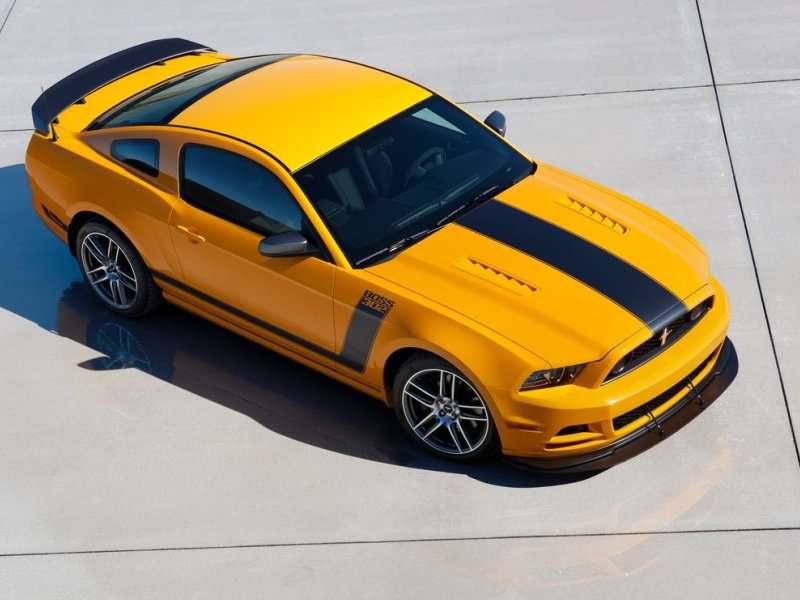
2013 Ford Mustang Boss 302 Road Test & Review: Comfort & Cargo
For the two lucky folks sitting in the Mustang’s front seats, all is well—particularly with the Recaro seating option. Cloth upholstery rather than leather covers the Boss 302 seats to reduce slipping and sliding when the Mustang is cornering vigorously. Legroom and headroom are first rate, though there are some pretty significant blind spots to consider.
As you might imagine, the rear seats are best suited to small children, packages, purses and briefcases. We’re talking about a Mustang here, so trunk space, while suitable for carry on luggage, isn’t going to be conducive to overly large suitcases and etc.
Still, as performance cars go, the Mustang is reasonably comfortable and relatively commodious.
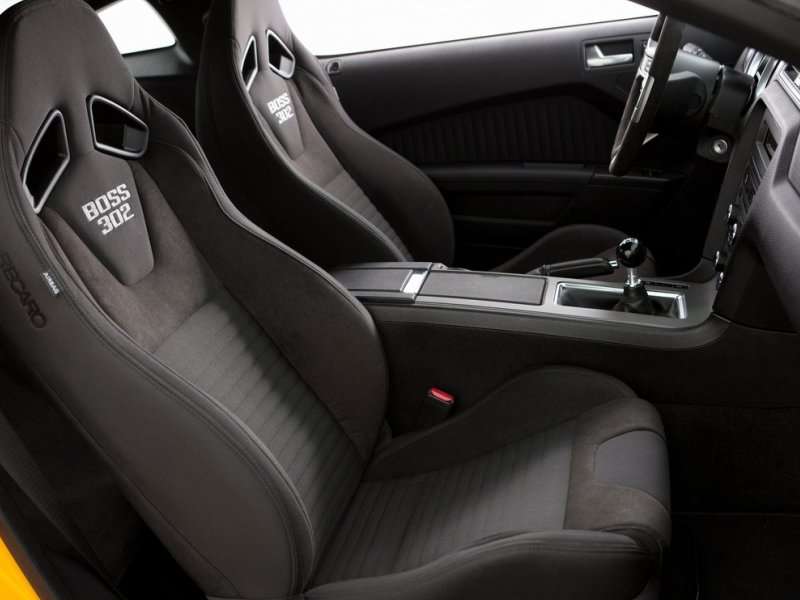
2013 Ford Mustang Boss 302 Road Test & Review: Features & Controls
While the interior treatments of base Mustang models have been criticized for looking, shall we say, inexpensive—opt for a premium version like our test Boss 302 and those concerns will be somewhat alleviated with nicer upholstery and additional trim.
Regardless of the Mustang package you choose though, seated behind the meaty steering wheel you will face a brace of chrome ringed gauges, whose shape are mirrored artistically by the air vents. The 180-mph speedometer hints at the performance potential of the Mustang Boss 302, as does the 7,500 rpm redline on the tachometer.
In our test car, the six-speed manual transmission used a cue ball type shift knob, in yet another nod to Mustang’s past. Ford’s designers are clearly in touch with the heritage of the car they’ve been entrusted with and unashamedly invoke whenever it makes sense. Similarly, the one-piece dash cap, with its dual “visors” recall the dash treatment of early Mustangs, while bringing the look forward in a wholly contemporary fashion.
For 2013, a new 4.2-inch LCD screen behind the steering wheel displays information related to fuel economy and vehicle performance. A five-way control button on the steering wheel enables cycling through the readouts. The Track Apps display housed within it measures g-forces, acceleration times in quarter-mile and 0-60 increments, and braking times. The timing function supports both automatic and countdown starts.
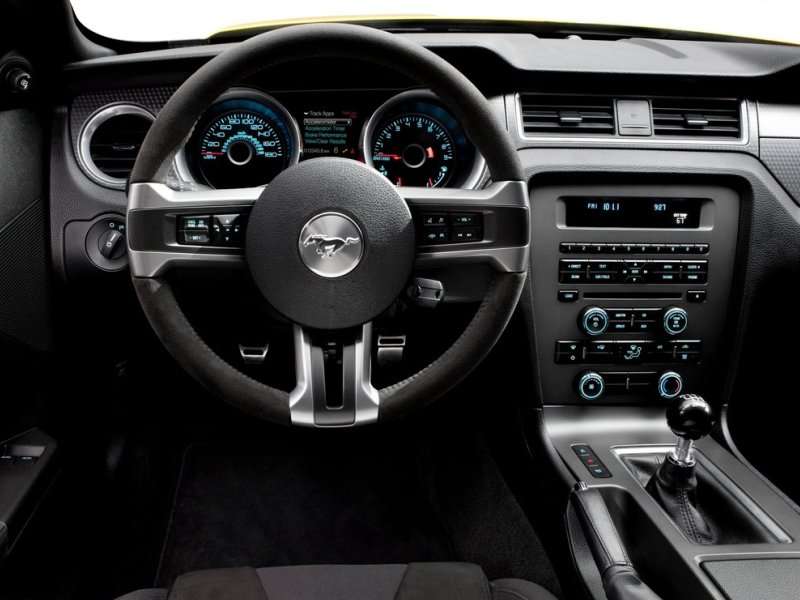
2013 Ford Mustang Boss 302 Road Test & Review: Powertrain and Fuel Economy
An old saying goes, "It’s what’s up front that counts." When it comes to the 2013 Ford Mustang Boss 302, what’s up front is an even more potent version of the freest winding V8 engine we’ve ever seen in an American muscle car. Featuring forged pistons, sodium-filled valves, high=performance valve springs, an oil cooler, and high-lift cams, the Boss 302’s engine boasts a 7500-rpm redline.
The unique quad exhaust system applied to the car runs outlets at the sides of the car as well as at the rear. This reduces backpressure in the engine to permit freer winding. Output is quoted at 444 horsepower and 380 ft-lbs of torque. Wind this engine to that redline in the lower gears and you’ll be treated to one of the sweetest sounds in the entire automotive universe.
Ford claims 0 to 60 in under five seconds, and the quarter in around 13 seconds. Our decidedly unscientific, impromptu runs against a stopwatch returned evidence sufficient to make the company’s claims more than plausible. Ford also offers a “TracKey” option to unleash even more performance from the Boss 302. Go with TracKey and you’ll get a red second key. When you employ it to start the Boss 302, the red key communicates with the TracMode software to enable the Mustang’s two-stage launch control as well as its full race calibration
The only transmission offering for the Boss 302 is Ford’s six-speed manual. Boasting short, positive throws, we found it to be very user friendly and highly conducive to making a lot of speed. Clutch effort was minimal and the engine’s generous supply of torque made setting off from rest a very simple matter.
The EPA says the Mustang Boss 302 will return 15 mpg in the city and 26 on the highway. Of course, that’s driven conservatively. In the real world, with our frequent dashes to redline, we averaged around 17 mpg combined.,

2013 Ford Mustang Boss 302 Road Test & Review: Driving Impressions
Around town, when used gently, the V8 is a very willing errand runner. The engine is perfectly happy short shifting and doesn’t goad you into smoky burnouts on Broadway on your way home from the grocery store.
Get it out on your favorite open road though and you’ll see right away where the extra money was spent. The Mustang Boss 302 just flat loves to run. The transmission always finds the right gear, exhibiting no balkiness whatsoever. The Brembo package erased speed the way reformatting a memory card in your digital camera makes pictures disappear. The braking system pulls the car down repeatedly from really high speeds with no evidence of fade whatsoever.
While the electric steering system could return better steering feel, it is very accurate and you very quickly come to trust it will communicate your intentions to the front wheels. Our favorite setting—as you might imagine—was the sport mode, giving a nice balance between steering effort and rate of response. Turn-in is nice and gradual, after dancing around on its suspension a bit (the way all Mustangs do); the Boss 302 takes a set and charges toward the apex on your chosen line.
While it takes a bit of getting used to before you fully trust the Mustang because of this tendency, you eventually come to realize that’s just the way the car is and soon you’re galloping into corners with a full head of steam. Yes, the ride quality is stiffer than a Taurus, but given the overall capabilities of the car, it’s a trade off we freely accept.
One thing we do have a significant beef about is the placement of the cupholders behind the shifter. Strategically positioned where they can be the most encumbering when occupied, they really impede intuitive usage of the transmission. But hey, if you’re using the cupholders, you probably ain’t using the car right—so that one could go either way.
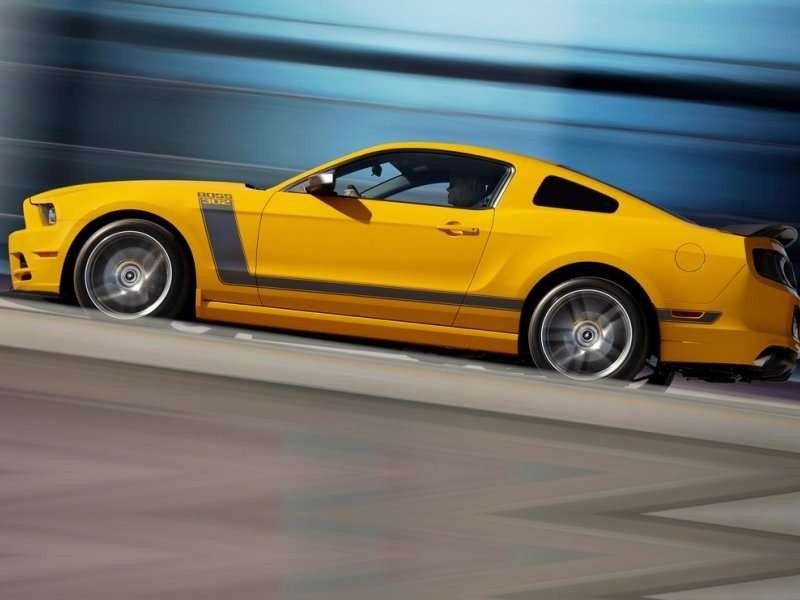
2013 Ford Mustang Boss 302 Road Test & Review: Safety Equipment
Mustang’s suite of safety gear includeshigh-strength steel in its body structure and ultra-high-strength steel in the door intrusion beams for maximizing side-impact protection.
The front structure's crush zones absorb crash energy and help dissipate it before it reaches the passenger compartment. The octagonal shape of the Mustang's front rails also help spread crash forces evenly to protect the vehicle’s occupants.
Additional standard safety equipment includes the Ford Personal Safety System, which features dual-stage driver and front passenger air bags, seat belt pretensioners and Ford’s Belt-Minder.
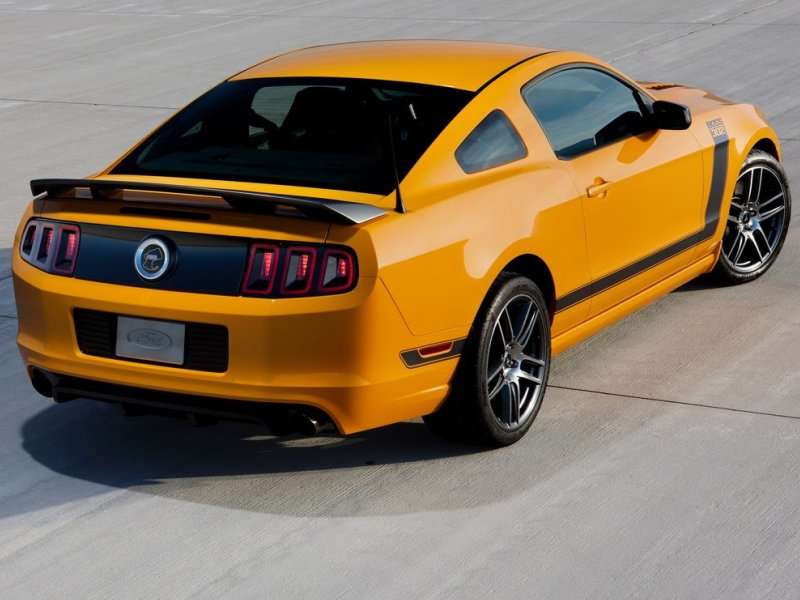
2013 Ford Mustang Boss 302 Road Test & Review: Final Thoughts
There have been a number of extraordinary cars wearing the galloping pony logo over the years. With this latest update, and the development of this exceptionally smooth and free-winding V8 engine, Ford’s engineering team has demonstrated it is fully capable of developments equal to that of any other manufacturer.
Our 2013 Mustang Boss 302 test car, while admittedly costly starting at $42,200, is very close to being a world-class performance car. It’s fast, comfortable and well appointed. This Mustang Boss 302 also offers remarkable comfort and convenience features in the form of the Ford/Microsoft Sync telematics system, which enables voice actuation of everything from the navigation system to calling up a track of music on your iPod.
Dynamically entertaining, albeit a bit less than completely buttoned down in the handling department, the Mustang Boss 302 more than holds its own against the comparable Chevrolet Camaro and Dodge Challenger models. One day in the very near future we’re going to look back at all of these cars and realize we were living in a golden era of performance
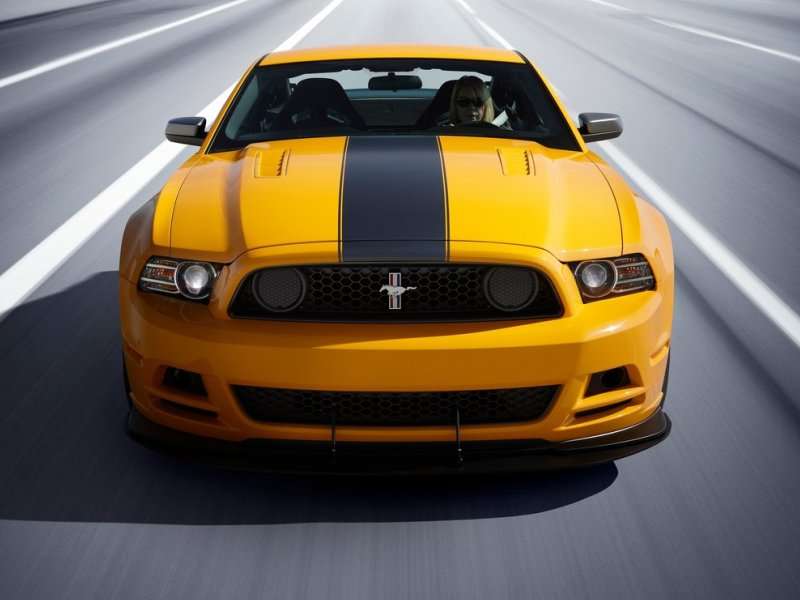
2013 Ford Mustang Boss 302 Road Test & Review: Pros & Cons
• Outstanding performance potential
• Handsome styling
• Sharp handling
• Brilliant engine
• Cramped rear seat
• Interior treatment could be nicer for $42,000
• Wait, a $42,000 Mustang? Hmmm…
